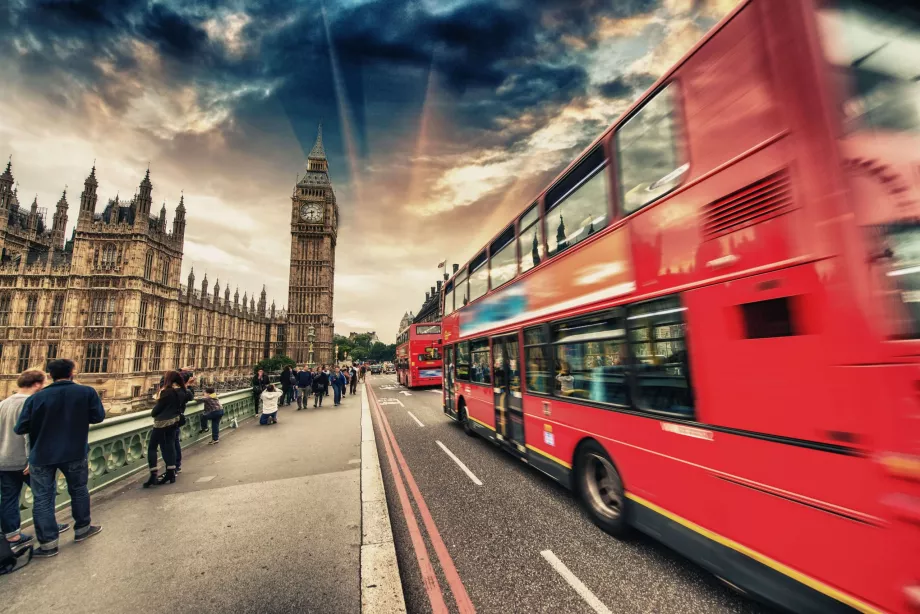Weather in London and best time to go

Most of the activities that people come to London for are not weather-related. One thing that must always be taken into account is the possible rain and wind that accompanies all seasons, especially during the winter.
Compare flight prices to London
However, you don't have to reckon with any extremes here, it very rarely freezes or snows, and summer temperatures generally stay at or below 25°C anyway.
Spring is usually very pleasant, but don't forget to pack an umbrella or raincoat. The parks are blooming beautifully and it's a pleasant 12-18°C for walking around the city.
London during the year
Here's what the weather looks like in London during the different months of the year.
Weather in January
January is one of the coldest months in London, with average temperatures between 5 and 8 °C. However, snow is also a rare occurrence during this period and only appears in large quantities once every few years.
On the other hand, rain is very frequent, usually in the form of short showers, but overcast and gloomy skies can last for many days at a time. This makes January an ideal month to visit museums, galleries and indoor sights, as well as to shop the post-Christmas sales.
Weather in February
The bitter winter weather with temperatures around 9°C, frequent showers and cold winds continues during February.
Skies are mostly cloudy or overcast, but some sunshine does break through. February, like January, is the perfect month to visit museums, monuments and galleries.
Weather in March
During March, spring slowly emerges. Temperatures in London slowly climb to an average of 11°C, with more frequent breaks in the sky and a slight decrease in showers compared to winter.
But that doesn't mean you won't get wet, with brief showers to be expected every day. Statistically, however, it rains the least in March of the whole year.
Weather in April
April weather in London brings with it frequent changes between rain, sunny skies and heavy steel clouds. Temperatures soar to an average of 15°C and the grass and trees in the parks start to turn beautifully green.
Prepare for often surprisingly cold winds, especially on the banks of the Thames, and increasingly chilly evenings and nights.
Weather in May
London's spring is in full swing, with Hyde Park and other natural areas in bloom and lush green. Normal daytime temperatures rise to 18°C, but mornings can be chilly with temperatures below 9°C.
Rainfall in May is slightly below average, but that doesn't mean it won't rain at least once during your stay - however long it may be. There are, however, almost exclusively short showers.
Weather in June
June's weather beckons for long walks, with temperatures soaring to 21°C and the chances of constant clear weather more than 40%.
Showers occur about every 2nd or 3rd day, the air is usually cleansed by a fresh breeze and the sky is cloudy to partly cloudy.
Weather in July
July is the hottest month in London, with temperatures reaching 24°C, but there are also days when it is 26-27°C. However, extreme heat over 30°C is rare and occurs about once every 3 years.
Rainfall is similar to all other months. Light rain is always to be expected, but the chances of prolonged heavy rainfall are very small.
Weather in August
Statistically, August is one of the sunniest months in London. Clear skies with only small drifting clouds are very common, but that doesn't change the fact that light rain showers can occur at absolutely any time.
Temperatures are around 23 °C, but can drop to 15 °C at any time, especially towards the end of the month.
Weather in September
The last gasps of summer bring temperatures in London of around 20°C, with mostly partly cloudy weather and occasional showers every 3rd day or so.
Mornings and evenings are cooler and the first morning fogs appear towards the end of the month, blown in by a cool fresh wind during the day.
Weather in October
Autumn hits London in full force, first with the leaves on the trees gradually turning colour, then with temperatures dropping to around 15°C, but there are no exceptions when the thermometer doesn't exceed 11°C.
The rain is more frequent than in summer, the weather is drier, but prolonged, consistently overcast skies are the exception. Morning mists, on the other hand, are the norm, rolling low to the ground and creating magical views from London's vantage points, where you can see church spires and skyscrapers poking out of the mist.
The weather in November
November's weather can be described as typical London as we know it from the movies or detective stories. Morning fog often lingers until midday, when a cold wind blows it away, parks are decorated with layers of golden fallen leaves and temperatures rarely get above 11°C.
The weather is generally damp and cloudy with frequent showers, but the sun does find its way in from time to time to warm the chilly streets a little.
Weather in December
December is London's darkest month with the least sunshine and chilly temperatures of around 9 °C. Morning temperatures can drop below 3 °C. Overall, the weather is wet with frequent showers and fog and fresh winds, but these can paradoxically bring warmer ocean air.
Although it is dark early, London's streets are aglow with decorations and filled with a lovely pre-Christmas atmosphere.
Table of temperatures during the year
London - Temperatures during the year
When to go to London
Again, the rule of large metropolises applies here, head out whenever the activity you want to pursue.
For example, the London Eye is only open from May to December. Conversely, during winter is the perfect time to visit closed sights and attractions such as the British Museum or the Harry Potter studios.
If you want to go to the football and don't have tickets, don't go in May for the Premier League final. And if you're going shopping for bargains, aim your visit for late summer and after Christmas. On the other hand, if you want to experience a real shopping spree, head to London in the run-up to Christmas.
London is, in short, a year-round destination, with every month having its own charm.
Any questions left?
If you have any questions or comments about the article...

